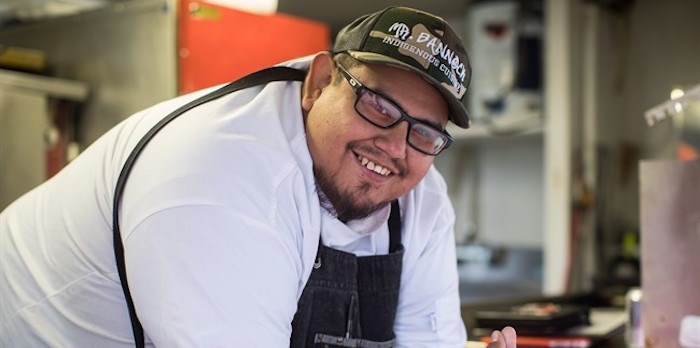Since Paul Natrall started serving Indigenous cuisine from his Mr. Bannock food truck in Vancouver nearly a year ago, the chef has hired several employees for his in-demand fusion food business.
In recent years, Indigenous-owned eateries like his have emerged in many Canadian cities serving traditional foods like bannock and buffalo. While it's taken time to move into the mainstream, chefs say demand is high thanks to increasing awareness of Indigenous culture and desire for local foods.
 Chef Paul Natrall poses for a photograph in the trailer where he operates his catering business on the Squamish First Nation, in North Vancouver, B.C., on Friday September 21, 2018. Since he started serving Indigenous cuisine from his Mr. Bannock food truck in Vancouver nearly a year ago, the chef has hired several employees for his in-demand fusion food business. In recent years, Indigenous-owned eateries like his have emerged in many Canadian cities serving traditional foods like bannock and buffalo. THE CANADIAN PRESS/Darryl Dyck
Chef Paul Natrall poses for a photograph in the trailer where he operates his catering business on the Squamish First Nation, in North Vancouver, B.C., on Friday September 21, 2018. Since he started serving Indigenous cuisine from his Mr. Bannock food truck in Vancouver nearly a year ago, the chef has hired several employees for his in-demand fusion food business. In recent years, Indigenous-owned eateries like his have emerged in many Canadian cities serving traditional foods like bannock and buffalo. THE CANADIAN PRESS/Darryl Dyck
"They're enjoying it. Like, everybody is going a little crazy," said Natrall of the reception to the bannock, tacos, chicken and waffles, and other dishes on his menu.
He's worked in the industry for about a decade and launched the truck last January after diners at his pop-up events kept asking when the chef would open a more permanent location.
There are a number of reasons why Indigenous cuisine has taken some time to emerge in major Canadian cities where there's a glut of other ethnic food choices.
First, as Natrall is quick to point, it's expensive to open a restaurant. He opted for a food truck because it was cheaper than servicing the big loan he'd need for a storefront.
While food is a big part of Indigenous culture — with the older generation teaching younger ones how to cook traditional fare — that opportunity was ripped away from the population for a long time, he said.
Government-funded, church-run residential schools operated in the country for more than a century with the last one closing in 1996. Indigenous children were forced to attend the schools where sexual, emotional and physical abuse was rampant.
The government also banned the potlatch, a ceremony practiced by some First Nations that includes feasting, for more than six decades in an effort to force assimilation.
Such policies prevented Indigenous people from practicing their food culture, Natrall said.
"So, it's been missing for a long time."
Food regulations can also make it difficult to serve authentic Indigenous cuisine as restaurants in much of Canada are not allowed to sell game meat that is hunted rather than raised in captivity.
It can also be hard to find certain traditional ingredients in stores, Natrall lamented, explaining how when he teamed up with some friends for a pop-up event in the States, they had to forage for some of the products.
Despite these obstacles, businesses like Mr. Bannock are becoming more prevalent in cities.
In Toronto, chef Johl Whiteduck Ringuette opened a restaurant, NishDish, last year after a dozen years of running his catering service of the same name. He serves traditional Anishnawbe food. The city also boasts chef Joseph Shawana's ku-kum and Ojibway taco spot the Pow Wow Cafe, among others.
But the scene is not limited to Toronto. Winnipeg's Feast Cafe Bistro serves a variety of bannock pizzas and Indian tacos while Vancouver's Salmon n' Bannock Bistro says its current staff represent a number of different First Nations.
Indigenous chefs who have been cooking for some time now say they're noticing more and more Indigenous chefs entering the industry.
In part, the growth comes from more Indigenous people living in cities, said chef David Wolfman of the Xaxli'p First Nation. Wolfman's career spans more than 20 years and his resume includes teaching at George Brown College's chef school, hosting a cooking TV program and publishing a cookbook, "Cooking with the Wolfman: Indigenous Fusion."
On most reserves there's usually a community kitchen and perhaps one restaurant, said Wolfman, and rarely enough business to justify multiple eateries. So Indigenous cooks have realized other towns and cities can be an avenue to showcase their foods, he said.
"I think, in our core, it's about sharing our food and knowledge."
Social and traditional media have also helped make the public more aware of Indigenous food and culture, he said, raising people's curiosity.
In general, people are more interested in where their food comes from nowadays, said Wolfman, giving Indigenous cuisine a boost as it is often considered local food.
For Natrall, who hopes to expand his food truck into a restaurant one day, "it's about time" for Indigenous food to have its moment in the spotlight.
"We couldn't concentrate on developing or perfecting Indigenous cuisine, so it's taken longer than others, I guess," he said.
"But, everybody's hitting the right stride and it's finally coming to, right. So, it's awesome."
Follow @AleksSagan on Twitter.
![]()


